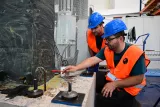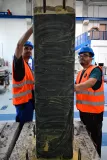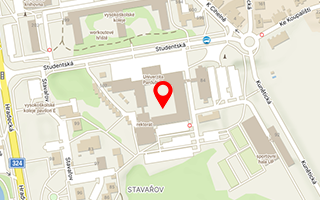Published: 16.06.2025
They produce two-ton concrete columns. In the lab, they test what the columns can withstand, repair their damaged parts, and test them again. With their help, experts from the Jan Perner Faculty of Transport Engineering are discovering how to improve, reinforce, or repair structures to make them more durable, even in earthquakes.
It was on Monday, 6 February 2023. At 4:45 in the morning, Turkey was waking up to a new day – just another ordinary day. Suddenly, the morning quiet was interrupted by an earthquake, and not a weak one at that... It lasted about 70 seconds, with the tremors reaching as high as 8 on the Richter scale, which is amongst the highest values. The aftershocks lasted for another six hours with a magnitude of up to 6.7. Hundreds of thousands of residents were trapped in destroyed buildings. It is not unusual for an earthquake to strike where the earth's plates meet, but it was the first of this magnitude in over 80 years.
Some building structures in Pardubice experience similar stresses as in the earthquake. However, the locals do not notice it because these experiments are under control. They are conducted in a unique Centre for Education and Research in Transport laboratory, where Ladislav Řoutil and his Turkish colleague Özgür Yurdakul work. It has been 10 years since they met at the university. Their relationship, initially mentoring, started with Özgür's PhD thesis and gradually turned into a collegial one. This formed the basis of a research team that includes several other colleagues today.
Laboratory behind a massive door
The research team's laboratory is located in the technological complex in Doubravice. From the entrance, we head to the back of the complex and look for a sizeable grey door. It is behind them that the experiments take place. On the way to the lab, we pass massive concrete columns on the left. These are currently tested structural elements designed by local experts and manufactured by a specialist company. The pair of scientists have dedicated their research to the collapse of building structures. That is why they take care to subject the parts of buildings or transport infrastructure under study to different types of loading. They look for their weak points and ways to strengthen them. In this way, they improve the mechanical response of reinforced concrete structures and listed buildings.
"Here, we investigate how a reinforced concrete structure behaves in response to normal and extreme loads caused by various influences. We try to trace where damage occurs in structures, when and where cracks form, and how they propagate through the material. At the same time, we need to describe the factors behind that. We follow the process from both an experimental and computational point of view, using advanced numerical models," begins Ladislav Řoutil, who starts the tour of the laboratory and explains what they want to achieve with their research. "Our research helps to design reliable building structures that meet the requirements for safety, economy, and long-term sustainability," he adds. They also strive to consume as few raw materials as possible.
Experiment as the research basis
Concerning testing, the researchers use custom-made parts of concrete structures. "These actual ones are made of reinforced concrete, weigh two tonnes, and are quite difficult to handle. We also use a crane for this, so we must have crane tests," explains Özgür Yurdakul as we stand in the high-ceiling laboratory. It looks more like a construction site, with a reinforced concrete column waiting to be tested. A little further on, another one has already passed a similar experiment. It is visibly damaged. In some places, the concrete is hollowed out; in others, cracks reveal steel reinforcement or wires sticking out. These wires are crucial for testing. They are part of the strain gauges installed in the blocks when poured and give scientists the data they need. "Strain gauges are used as sensors to measure mechanical stress indirectly. We've carefully planned their deployment. They must not be damaged during the concrete pouring process and must remain in place," says Özgür, adding that until recently, the parts of the structures to be tested were made by the researchers themselves. However, the need for the parts continuously increased until the team could not provide everything themselves, so they hired a partner company to manufacture them.
The structures so designed can finally be tested by the researchers. One test lasts about five days, including preparation and clean-up. Partial loading takes place throughout the day. "Even though we carry out a load test, we must prevent total destruction. That would also damage the experimental equipment, which we don't want. If necessary, the test must be stopped in time, which is closely supervised by Özgür together with his team colleague, Reader Bohumil Culek, who analyses the data here on the screen," notes Řoutil. However, damage to the tested structure is bound to occur. It is then repaired, together with the cracks, by the experts, and the whole structure is retested.
Testing (not only) Turkish structures
Scientists use a unique process to strengthen or rehabilitate concrete structures by applying carbon slats to selected areas. "This procedure is proving to be very effective for the additional reinforcement of various building structures. We are currently testing whether our procedures are also applicable in areas with a risk of earthquakes," adds Özgür. Not only in Turkey, reinforced concrete buildings have various structural deficiencies. "They're, for example, the result of inappropriate technical design or poor material quality, such as using low-strength concrete," he explains. Problems are also caused by improper design and inadequate inspection mechanisms, he says, and the use of steel reinforcement in building structures. "The surface finish of the reinforcement is typically ribbed, which improves the cohesion between the reinforcement and the concrete. But in Turkish structures, the reinforcement is often smooth, negatively affecting this cohesion," adds Řoutil on the composition of reinforced concrete.
Therefore, they are developing procedures to ensure that further earthquakes in Turkey will not cause as much damage. Yet, the scientists do not import the Turkish parts of the buildings as souvenirs from Turkey to Pardubice. They use custom-made parts of the structures with the same composition as Turkish masonry for testing. Occasionally, the supplier of the constructions wants to make sure that there is no mistake in the composition as, to his surprise, it is very different from the Czech standards. The only thing the researchers bring back from Turkey is data directly from the field. Özgür went to a damaged area in Turkey after the last earthquake. Such scenarios serve as a laboratory for civil engineers, so he and his Turkish colleagues have collected important data from damaged structures that are opening up new horizons for the group and pushing testing ever further.
More research to come
For these purposes, Pardubice scientists are also planning research on using shape memory alloys. They have recently started developing and testing systems for damping vibrations of structures using specially developed non-Newtonian fluids. They and their foreign partners have already received a prestigious European grant for this research. Thanks to their membership in international committees, they are involved, for example, in incorporating research results into standards for designing structures across Europe. Özgür Yurdakul is very active in this respect. Not only does he serve on The International Federation for Structural Concrete (FIB), but he also fosters research with his enthusiasm and drive.
Doc. Ing. Ladislav Řoutil, Ph.D., has worked at the Jan Perner Faculty of Transport Engineering since 2012. He deals with structures and transport buildings, mechanics and statics of building structures, and modelling of their damage. In the past, he was awarded the "Outstanding Dissertation in Concrete" in the competition of the Czech Concrete Society. He publishes articles in professional journals and is involved in several research projects, and last year, he was appointed a Czech representative to Europe's Rail Scientific Committee.
Ing. Özgür Yurdakul, Ph.D., comes from Ankara, Turkey. He studied civil engineering and has worked on the topic since his dissertation. He has been researching and living in Pardubice for about ten years. Immediately after his arrival, he became part of Řoutil's research team. He brings interesting international contacts to the team. For example, he worked as a postdoc in Naples, Italy. He is a member of the prestigious International Federation for Structural Concrete (FIB).
STORY BY Zuzana Paulusová : PHOTO BY Adrián Zeiner



